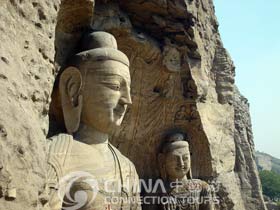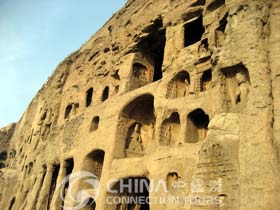 Located at the southern foot of Wuzhou Mountain some 16 kilometers west of Datong City, Shanxi Province, contain China's largest and earliest stone sculpture, Yungang Grottoes were built against the mountain and extend about 1 kilometer (0.62 miles) from east to west. These are known as one of the three major Grottoes in China. The construction of the caves was started under the auspices of the noted monk Tan Yao in 453 and took 50 years to complete. Some 40,000 people, including the Buddhists from what is present Sri Lanka, contributed to the huge project. The art of the Yungang Grottos may be considered a manifestation of a process of blending of cultures and religions, a process of giving a Chinese touch to Buddhist art that, at that time, was essentially Indian. Nowadays the Yungang Grottoes still boast over 1,100 shrines and niches of widely varying sizes and no less than 50,000 sculptures of Buddha and Bodhisattvas.
Located at the southern foot of Wuzhou Mountain some 16 kilometers west of Datong City, Shanxi Province, contain China's largest and earliest stone sculpture, Yungang Grottoes were built against the mountain and extend about 1 kilometer (0.62 miles) from east to west. These are known as one of the three major Grottoes in China. The construction of the caves was started under the auspices of the noted monk Tan Yao in 453 and took 50 years to complete. Some 40,000 people, including the Buddhists from what is present Sri Lanka, contributed to the huge project. The art of the Yungang Grottos may be considered a manifestation of a process of blending of cultures and religions, a process of giving a Chinese touch to Buddhist art that, at that time, was essentially Indian. Nowadays the Yungang Grottoes still boast over 1,100 shrines and niches of widely varying sizes and no less than 50,000 sculptures of Buddha and Bodhisattvas.
The Yungang Grottoes are divided into three zones: east, west and central and numbered from east to west. Grottos No.1 and No. 2 are located in the east zone. Statues and sculptures inside these caves have been severely damaged by exposure to the elements, but still preserved in the east zone are relief sculptures of Buddhist stories on the lower part of the eastern wall of Grotto No. 1. Inside the entrance of the Yungang Temple is an impressive four-storied wooden façade with glazed top outside the Grottos Nos. 3, 4 and 5. Most of the grottoes are in the western zone, and each has its own character. Grotto No. 20 – one of the five earliest caves of monk Tan Yao – houses the sitting statute of Sakyamuni, 13.7 meters high, with a full and round face with a majestic smile, slim lips and a high nose, ears that extend almost to the shoulders, radiant eyes and broad shoulders. Sakyamuni statue is representative of Buddha sculptures in Yungang Grottoes.
 Over the past 1,500 years since their completion, Yungang Grottoes have been damaged by both war and natural disasters. After the founding of the People's Republic of China in 1949, the Chinese government attached great importance to the preservation of the grottoes. A special Yungang Grottoes protection institution was set up in 1995, and in 1961, the State Council listed Yungang Grottoes as key cultural site under its protection. In 1965, the Datong municipal government issued and implemented the Programs for the Protection Scope and Safety of Yungang Grottoes. From 1973 to 1976, under the instruction of Premier Zhou Enlai, China injected a huge sum of money into the grottoes, rescuing many grottoes and caves that had been on the verge of collapse. In December 2001, the 25th meeting of UNESCO World Heritage Committee in Helsinki, Finland, passed a decision to list Yungang Grottoes on the World Cultural Heritage List.
Over the past 1,500 years since their completion, Yungang Grottoes have been damaged by both war and natural disasters. After the founding of the People's Republic of China in 1949, the Chinese government attached great importance to the preservation of the grottoes. A special Yungang Grottoes protection institution was set up in 1995, and in 1961, the State Council listed Yungang Grottoes as key cultural site under its protection. In 1965, the Datong municipal government issued and implemented the Programs for the Protection Scope and Safety of Yungang Grottoes. From 1973 to 1976, under the instruction of Premier Zhou Enlai, China injected a huge sum of money into the grottoes, rescuing many grottoes and caves that had been on the verge of collapse. In December 2001, the 25th meeting of UNESCO World Heritage Committee in Helsinki, Finland, passed a decision to list Yungang Grottoes on the World Cultural Heritage List.

